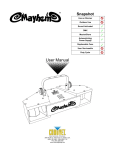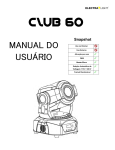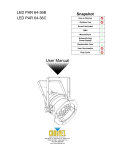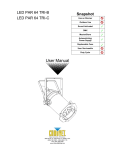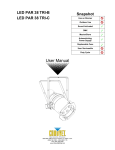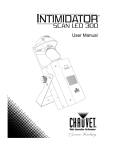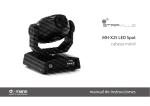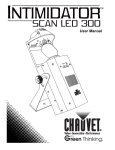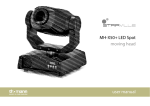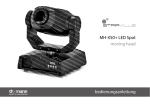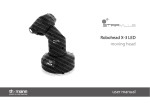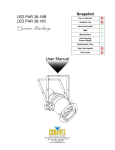Download Chauvet Intimidator Spot XYZ User manual
Transcript
Snapshot Use on Dimmer Outdoor Use Sound Activated DMX Master/Slave 115 V / 230 V Voltage Selection Switch Replaceable Fuse User Serviceable Duty Cycle User Manual 3000 N 29th Ct, Hollywood, FL 33020 U.S.A. (800) 762-1084 – (954) 929-1115 FAX (954) 929-5560 www.chauvetlighting.com TABLE OF CONTENTS 1. BEFORE YOU BEGIN ................................................................................................................................................... 3 WHAT IS INCLUDED ................................................................................................................................................................................ 3 UNPACKING INSTRUCTIONS .................................................................................................................................................................... 3 MANUAL CONVENTIONS ......................................................................................................................................................................... 3 ICONS .................................................................................................................................................................................................. 3 SAFETY INSTRUCTIONS .......................................................................................................................................................................... 4 2. INTRODUCTION ........................................................................................................................................................... 5 FEATURES ............................................................................................................................................................................................ 5 PHOTOMETRICS .................................................................................................................................................................................... 5 PRODUCT DIMENSIONS .......................................................................................................................................................................... 6 PRODUCT OVERVIEW............................................................................................................................................................................. 7 3. SETUP .......................................................................................................................................................................... 8 AC POWER........................................................................................................................................................................................... 8 Power Linking ........................................................................................................................................................... 8 Signal Linking (DMX) ................................................................................................................................................ 9 Fuse Replacement .................................................................................................................................................... 9 MOUNTING.......................................................................................................................................................................................... 10 Orientation .............................................................................................................................................................. 10 Rigging ................................................................................................................................................................... 10 4. OPERATING INSTRUCTIONS .................................................................................................................................... 11 CONFIGURING THE STARTING ADDRESS ................................................................................................................................................ 11 CONTROL PANEL FUNCTIONS ............................................................................................................................................................... 11 MENU MAP ......................................................................................................................................................................................... 12 DMX OPERATION................................................................................................................................................................................ 13 MENU MAP (SERVICE) ......................................................................................................................................................................... 13 STANDALONE OPERATION .................................................................................................................................................................... 14 Automatic Fast ........................................................................................................................................................ 14 Automatic Slow ....................................................................................................................................................... 14 Sound-Active .......................................................................................................................................................... 14 Master/Slave ........................................................................................................................................................... 15 DMX CHANNEL VALUES ...................................................................................................................................................................... 16 5. APPENDIX .................................................................................................................................................................. 18 DMX PRIMER ..................................................................................................................................................................................... 18 GENERAL MAINTENANCE...................................................................................................................................................................... 18 FIXTURE LINKING................................................................................................................................................................................. 19 DATA CABLING .................................................................................................................................................................................... 19 DMX Data Cable ..................................................................................................................................................... 19 Cable Connectors ................................................................................................................................................... 19 3-Pin to 5-Pin Conversion Chart .............................................................................................................................. 20 SETTING UP A DMX SERIAL DATA LINK ................................................................................................................................................. 20 SETTING THE STARTING ADDRESS ........................................................................................................................................................ 20 GENERAL TROUBLESHOOTING .............................................................................................................................................................. 21 CONTACT US ...................................................................................................................................................................................... 21 RETURNS PROCEDURE ........................................................................................................................................................................ 22 CLAIMS .............................................................................................................................................................................................. 22 TECHNICAL SPECIFICATIONS ................................................................................................................................................................ 23 1. BEFORE YOU BEGIN What is included 1 x Intimidator™ Spot XYZ 1 x Mounting bracket and screws 1 x Power cable 1 x Warranty Card 1 x User Manual Unpacking Instructions Immediately upon receiving a fixture, carefully unpack the carton, check the contents to ensure that all parts are present, and have been received in good condition. Notify the shipper immediately and retain packing material for inspection if any parts appear damaged from shipping or the carton itself shows signs of mishandling. Save the carton and all packing materials. In the event that a fixture must be returned to the factory, it is important that the fixture be returned in the original factory box and packing. Manual Conventions CHAUVET manuals use the following conventions to differentiate certain types of information from the regular text. MEANING CONVENTION [10] <Menu> A DIP switch to be configured A key to be pressed on the fixture’s control panel 1~512 A range of values 50/60 A set of values of which only one can be chosen Settings MENU > Settings ON A menu option not to be modified (for example, showing the operating mode/current status) A sequence of menu options to be followed A value to be entered or selected Icons This manual uses the following icons to indicate information that requires special attention on the part of the user. MEANING ICONS This paragraph contains critical installation, configuration or operation information. Failure to comply with this information may render the fixture partially or completely inoperative, cause damage to the fixture or cause harm to the user. This paragraph contains important installation or configuration information. Failure to comply with this information may prevent the fixture from functioning correctly. This paragraph reminds you of useful, although not critical, information. 1. Before You Begin 3 10/9/2009 2:29 PM Safety Instructions Please read these instructions carefully. It includes important information about the installation, usage and maintenance of this product. Please keep this User Manual for future consultation. If you sell the unit to another user, be sure that they also receive this instruction booklet. Always make sure that you are connecting to the proper voltage, and that the line voltage you are connecting to is not higher than that stated on the decal or rear panel of the fixture. This product is intended for indoor use only! To prevent risk of fire or shock, do not expose fixture to rain or moisture. Make sure there are no flammable materials close to the unit while operating. The unit must be installed in a location with adequate ventilation, at least 20 in (50 cm) from adjacent surfaces. Be sure that no ventilation slots are blocked. Always disconnect from power source before servicing or replacing fuse and be sure to replace with same fuse source. Secure fixture to fastening device using a safety chain. Maximum ambient temperature (Ta) is 104° F (40° C). Do not operate fixture at temperatures higher than this. In the event of a serious operating problem, stop using the unit immediately. Never try to repair the unit by yourself. Repairs carried out by unskilled people can lead to damage or malfunction. Please contact the nearest authorized technical assistance center. Never connect the device to a dimmer pack. Make sure the power cord is never crimped or damaged. Never disconnect the power cord by pulling or tugging on the cord. Never carry the fixture directly from the cord. Always use the hanging/mounting bracket. Avoid direct eye exposure to the light source while it is on. Never carry the fixture by holding the head. Always use the carrying handle. 1. Before You Begin 4 10/9/2009 2:29 PM 2. INTRODUCTION Features 11 or 16-channel DMX moving yoke Pan #1: 540° / pan #2: 540° / tilt: 540° Color wheel 7 colors + white Split colors Rainbow color spin at variable speeds Rotating gobo wheel with gobo shake 7 interchangeable gobos + open 5 metal, 2 glass installed Rotating gobo wheel spin at variable speeds 3-facet prism Variable electronic shutter (for strobing) Variable motorized focus Variable electronic dimmer (0 – 100%) Remote fixture reset & vector speed channel Individual reset of pan/tilt, color, gobo, prism, focus Move-in-black for pan/tilt, color, gobo Built-in movement macros via DMX (automated and sound) Additional Features Built-in automated programs via master/slave Built-in sound-active programs via master/slave High-power, 60 W, 14.9 A LED User-selectable pan/tilt ranges Pan: 540 , 360 , 180 Tilt: 270 , 180 , 90 Automatic pan & tilt correction User-selectable basic or advanced operating modes Additional power output: max 4 units Photometrics 2. Introduction 5 10/9/2009 2:29 PM Product Dimensions 2. Introduction 6 10/9/2009 2:29 PM Product Overview Pan #2 Tilt Front lens Pan #1 Control Panel Standing feet Voltage Selection Switch (115 V / 230 V) Fuseholder Power Input DMX Out DMX In Power Output Carrying handle 2. Introduction 7 10/9/2009 2:29 PM 3. SETUP AC Power This fixture runs on 115V or 230 VAC, 50/60 Hz. Before powering on the unit, make sure the line voltage to which you are connecting it to matches the current selection on the voltage selection switch. Always connect the fixture to a switched circuit. Never connect the fixture to a rheostat (variable resistor) or dimmer circuit, even if the rheostat or dimmer channel is used only as a 0 to 100% switch. Always connect the fixture to a circuit with a suitable electrical ground. The maximum quantity of fixtures that may be linked is 4. Power Linking This fixture contains power linking via the edison outlet located in front of the power input cable. Please see the diagram below for further explanation. Additional power link out 4. Operating Instructions 8 10/9/2009 2:29 PM Signal Linking (DMX) The diagrams below illustrate the signal (DMX) linking for this fixture. This is used both in DMX mode and when operating the fixtures in Master/Slave mode. Please see the diagram below for further explanation. First fixture Second fixture Third fixture Additional signal (DMX) link out DMX controller (only in DMX operation) Fuse Replacement Disconnect the power cord before replacing a fuse and always replace with the same type fuse. With a flat head screwdriver unscrew the fuse holder out of its housing, turning counter-clockwise. Remove the damaged fuse from its holder and replace with exact same type fuse. Insert the fuse holder back in its place and reconnect power. The fuse is located inside this fuseholder. 4. Operating Instructions 9 10/9/2009 2:29 PM Mounting Orientation The Intimidator™ Spot XYZ may be mounted in any safe position provided there is adequate room for ventilation. Rigging Be sure that the structure can support 10 times the weight of the fixture. Please see the “Technical Specifications” section of this manual for a detailed weight listing. Mount the fixture securely. Two hanging clamps for truss mounting may be used, or nuts and bolts for permanent installation may be used. The holes in each bracket are 13 mm in size. When rigging, consider routine maintenance and control panel access. Please see the following steps for installation. If the power link out is intended to be used with multiple fixture, take into account the length of each power cable, and mount the fixtures close enough to one another to accommodate for this. Attach both included bolts in the locations indicated below, using a metric 8 mm Allen wrench. Attached 2 hanging clamps to the bracket in each of the two locations indicated below Safety cables must always be used. Do NOT mount this fixture sideways! Mounting bracket Hanging clamp attachment point Bolt locations Safety cable attachment point Be sure to loop the safety cable through the 2 loops, as shown in the illustration above. The safety cable must be capable of support up to 10 times the weight of the fixture. 4. Operating Instructions 10 10/9/2009 2:29 PM 4. OPERATING INSTRUCTIONS Configuring the Starting Address Each fixture requires a starting address from 1~512. A fixture requiring one or more channels for control begins to read the data on the channel indicated by the starting address. For example, a fixture that uses seven DMX channels and is addressed to start on DMX channel 100, will read data from channels: 100, 101, 102, 103, 104, 105 and 106. Choose the starting addresses for each fixture so that the channels used do not overlap. In addition, you should note the starting address selected for future reference. The Intimidator™ Spot XYZ fixture uses eleven or sixteen DMX channels. If this is your first time using DMX, we recommend reading the “DMX Primer” section in the “Appendix”. Control Panel Functions Access control panel functions using the four buttons located directly underneath the LED display on the included wired remote. BUTTON FUNCTION <MENU> Used to scroll through the current operating mode, as well as back out of the current menu option <DOWN> Used to select decreasing advancement in the value <UP> Used to select increasing advancement in the value <ENTER> Used to select a value and store it to memory The Control Panel shows the current state of the unit. It is used to select the operating mode, as well as the sub-features. For a detailed layout of the control panel functions, please see the “menu map” section on the following page. 4. Operating Instructions 11 10/9/2009 2:29 PM Menu Map SELECTION MODE DISPLAY SELECTION ~ INSTRUCTION Set the DMX starting address Standalone-Slow: selection Standalone-Slow: mode display Standalone-Fast: selection Standalone-Fast: mode display Standalone-Sound: selection Standalone-Sound: mode display Standalone-Slave: selection Sets the fixture to respond to another fixture set to master Standalone-Slave: mode display Sets the fixture to respond to another fixture set to master Pan #1 Invert: selection Pan #1 Invert: mode display Pan #2 Invert: selection Pan #2 Invert: mode display Tilt Invert: selection Tilt Invert: mode display Display Invert: selection Display Invert: mode display Channel Personality (Advanced) Channel Personality (Basic) Pan #1 540° Pan #1 360° Pan #1 180° Pan #2 540° Pan #2 360° Pan #2 180° Tilt 540° Tilt 360° Tilt 180° Reset Load Default 4. Operating Instructions 12 10/9/2009 2:29 PM DMX Operation This is the operating mode which will allow for control with an external DMX controller. You must set the starting address for this mode. If this is your first time using DMX, then it is recommended that you refer to the “DMX Primer” section in the “Appendix” of this manual. 1. 2. Press <MENU> until Press <ENTER>. appears on the LED screen. 3. 4. Using <UP> and <DOWN>, select the desired DMX address (~). Press <ENTER>. Menu Map (Service) This fixture has a hidden menu. The purpose of this menu is to adjust the home position (electronic adjustment) of the attributes listed below. MAIN FUNCTION SELECTION ~ ~ ~ ~ ~ INSTRUCTION Adjustment for Pan #1 Adjustment for Tilt Adjustment for Pan #2 Adjustment for the Color Wheel Adjustment for the Gobo Wheel Please see the instructions below to access this hidden menu: 1. 2. 3. Press <MENU> for at least 10 seconds. Using <UP/DOWN>, enter the following pass code: “2323”. Press <UP> to change the blinking digit in ascending order, and press <DOWN> to move on to the next digit. Press <ENTER>. This mode will be automatically terminated after 10 seconds of being idol. These settings are set to 128 by default. The affect these settings. 4. Operating Instructions 13 option in the control panel will not 10/9/2009 2:29 PM Standalone Operation Automatic Fast This fixture has preprogrammed fast chases. These are accessed via the control panel. Please see the instructions below for further explanation. 1. 2. Press <MENU> until Press <ENTER>. , 3. 4. Using <UP> and <DOWN>, select Press <ENTER> to confirm settings. , , or appears on the LED screen. . Automatic Slow This fixture has preprogrammed slow chases. These are accessed via the control panel. Please see the instructions below for further explanation. 1. 2. Press <MENU> until Press <ENTER>. , 3. 4. Using <UP> and <DOWN>, select Press <ENTER> to confirm settings. , , or appears on the LED screen. . Sound-Active This fixture has preprogrammed sound triggered chases. These are accessed via the control panel. Please see the instructions below for further explanation. 1. 2. Press <MENU> until Press <ENTER>. 3. 4. Using <UP> and <DOWN>, select Press <ENTER> to confirm settings. 4. Operating Instructions , , , or appears on the LED screen. . 14 10/9/2009 2:29 PM Master/Slave This is the operating mode which will allow one fixture to act as the “master” and control all of the other “slave” fixtures. You must set both the master and the slave(s) fixtures to the correct mode for this operation. Please see the diagram below on the connections for your fixtures, as well as the setting to assign in the control panel. It is not necessary to arrange the master fixture as the first fixture in the daisy chain. It may be any fixture in the daisy chain. For example: fixture 2, 5, 10 or 12, etc. Only 1 fixture may be set to master. Do not connect a DMX controller to the daisy chain for this operating mode. In order to mirror one fixture to another, you may invert the pan and tilt on the mirrored fixture. Set this fixture to either or or Set this fixture to mode mode Master Slave Set this fixture to mode Slave Additional signal (DMX) link out 4. Operating Instructions 15 10/9/2009 2:29 PM DMX Channel Values Advanced Mode (16-channel) CHANNEL VALUE FUNCTION 1 Pan 1 000 255 0° 540° 2 Tilt 000 255 0° 270° 3 Pan 2 000 255 0° 540° 4 Pan 1 fine 000 255 0° 3° 5 Tilt fine 000 255 0° 3° 6 Pan 2 fine 000 255 0° 3° 7 Pan/tilt speed 000 255 Fast Slow 8 000 007 008 015 016 023 024 031 032 039 040 047 048 055 056 063 064 071 072 079 080 087 088 095 096 103 104 111 112 119 120 127 128 191 192 255 Color Wheel White (open) Blue Yellow Peachblow Green Pink Cyan Orange White + Blue Blue + Yellow Yellow + Peachblow Peachblow + Green Green + Pink Pink + Cyan Cyan + Orange Orange + White Rotating clockwise with increasing speed Rotating counter-clockwise with increasing speed 000 003 004 007 008 215 216 255 Shutter Shutter closed Open Strobe (slow fast) Open 9 10 11 Gobo Wheel Open Gobo 1 (glass) Gobo 2 (glass) Gobo 3 Gobo 4 Gobo 5 Gobo 6 Gobo 7 Gobo 7 shake, fast to slow Gobo 6 shake, fast to slow Gobo 5 shake, fast to slow Gobo 4 shake, fast to slow Gobo 3 shake, fast to slow Gobo 2 (glass) shake, (fast slow) Gobo 1 (glass) shake, (fast slow) Open Gobo scroll: Clockwise rotation Gobo scroll: Counter-clockwise rotation 4. Operating Instructions VALUE 12 000 015 016 127 128 239 240 255 Gobo Rotation Stop Rotate Counter-clockwise (slow fast) Rotate Clockwise (slow fast) Gobo bounce 000 007 008 015 016 023 024 031 032 039 040 047 048 055 056 087 088 095 096 103 104 111 112 119 120 127 128 135 136 143 144 151 152 159 160 255 Function No function Pan/tilt move-in-black Pan/tilt move-in-black (disable) Color wheel move-in-black Color wheel move-in-black (disabled) Gobo wheel move-in-black Gobo wheel move-in-black (disabled) No Function All movement move-in-black (disabled) Reset pan/tilt No Function Reset color wheel Reset gobo wheel No Function Reset prism Reset focus Reset all No function 14 000 007 008 023 024 039 040 055 056 071 072 087 088 103 104 119 120 135 136 151 152 167 168 183 184 199 200 215 216 231 232 247 248 255 Movement Macros No function Automatic 1 Automatic 2 Automatic 3 Automatic 4 Automatic 5 Automatic 6 Automatic 7 Automatic 8 Sound 1 Sound 2 Sound 3 Sound 4 Sound 5 Sound 6 Sound 7 Sound 8 15 Prism 000 007 Open 008 255 Stop, static prism effect 13 Dimmer 000 255 Closed Open 000 007 008 015 016 023 024 031 032 039 040 047 048 055 056 063 064 071 072 079 080 087 088 095 096 103 104 111 112 119 120 127 128 191 192 255 CHANNEL 16 16 0 255 FUNCTION Focus Near Far 10/9/2009 2:29 PM Basic Mode (11-channel) CHANNEL VALUE FUNCTION 1 Pan 1 000 255 0° 540° 2 Tilt 000 255 0° 270° 3 Pan 2 000 255 0° 540° 4 000 007 008 015 016 023 024 031 032 039 040 047 048 055 056 063 064 071 072 079 080 087 088 095 096 103 104 111 112 119 120 127 128 191 192 255 Color Wheel White (open) Blue Yellow Peachblow Green Pink Cyan Orange White + Blue Blue + Yellow Yellow + Peachblow Peachblow + Green Green + Pink Pink + Cyan Cyan + Orange Orange + White Rotating clockwise with increasing speed Rotating counter-clockwise with increasing speed 5 000 003 004 007 008 215 216 255 Shutter Shutter closed Open Strobe (slow fast) Open 6 000 007 008 015 016 023 024 031 032 039 040 047 048 055 056 063 064 071 072 079 080 087 088 095 096 103 104 111 112 119 120 127 128 191 192 255 Gobo Wheel Open Gobo 1 (glass) Gobo 2 (glass) Gobo 3 Gobo 4 Gobo 5 Gobo 6 Gobo 7 Gobo 7 shake, fast to slow Gobo 6 shake, fast to slow Gobo 5 shake, fast to slow Gobo 4 shake, fast to slow Gobo 3 shake, fast to slow Gobo 2 (glass) shake, (fast slow) Gobo 1 (glass) shake, (fast slow) Open Gobo scroll: Clockwise rotation Gobo scroll: Counter-clockwise rotation 4. Operating Instructions CHANNEL VALUE 7 000 015 016 127 128 239 240 255 Gobo Rotation Stop Rotate Counter-clockwise (slow fast) Rotate Clockwise (slow fast) Gobo bounce 8 000 007 008 015 016 023 024 031 032 039 040 047 048 055 056 087 088 095 096 103 104 111 112 119 120 127 128 135 136 143 144 151 152 159 160 255 Function No function Pan/tilt move-in-black Pan/tilt move-in-black (disable) Color wheel move-in-black Color wheel move-in-black (disabled) Gobo wheel move-in-black Gobo wheel move-in-black (disabled) No Function All movement move-in-black (disabled) Reset pan/tilt No Function Reset color wheel Reset gobo wheel No Function Reset prism Reset focus Reset all No function 9 000 007 008 023 024 039 040 055 056 071 072 087 088 103 104 119 120 135 136 151 152 167 168 183 184 199 200 215 216 231 232 247 248 255 Movement Macros No function Automatic 1 Automatic 2 Automatic 3 Automatic 4 Automatic 5 Automatic 6 Automatic 7 Automatic 8 Sound 1 Sound 2 Sound 3 Sound 4 Sound 5 Sound 6 Sound 7 Sound 8 10 Prism 000 007 Open 008 255 Stop, static prism effect 11 17 0 255 FUNCTION Focus Near Far 10/9/2009 2:29 PM 5. APPENDIX DMX Primer There are 512 channels in a DMX connection. Channels may be assigned in any manner. A fixture capable of receiving DMX will require one or a number of sequential channels. The user must assign a starting address on the fixture that indicates the first channel reserved in the controller. There are many different types of DMX controllable fixtures and they all may vary in the total number of channels required. Choosing a start address should be planned in advance. Channels should never overlap. If they do, this will result in erratic operation of the fixtures whose starting address is set incorrectly. You can however, control multiple fixtures of the same type using the same starting address as long as the intended result is that of unison movement or operation. In other words, the fixtures will be slaved together and all respond exactly the same. DMX fixtures are designed to receive data through a serial Daisy Chain. A Daisy Chain connection is where the DATA OUT of one fixture connects to the DATA IN of the next fixture. The order in which the fixtures are connected is not important and has no effect on how a controller communicates to each fixture. Use an order that provides for the easiest and most direct cabling. Connect fixtures using shielded two conductor twisted pair cable with three pin XLR male to female connectors. The shield connection is pin 1, while pin 2 is Data Negative (S-) and pin 3 is Data positive (S+). General Maintenance To maintain optimum performance and minimize wear, fixtures should be cleaned frequently. Usage and environment are contributing factors in determining frequency. As a general rule, fixtures should be cleaned at least twice a month. Dust build up reduces light output performance and can cause overheating. This can lead to reduced lamp life and increased mechanical wear. Be sure to power off fixture before conducting maintenance. Unplug fixture from power. Use a vacuum or air compressor and a soft brush to remove dust collected on external vents. Clean all glass when the fixture is cold with a mild solution of glass cleaner or Isopropyl Alcohol and a soft lint free cotton cloth or lens tissue. Apply solution to the cloth or tissue and drag dirt and grime to the outside of the lens. Gently polish optical surfaces until they are free of haze and lint. The cleaning of external optical lenses and/or mirrors must be carried out periodically to optimize light output. Cleaning frequency depends on the environment in which the fixture operates. Damp, smoky or particularly dirty surroundings can cause greater accumulation of dirt on the unit’s optics. Clean with soft cloth using normal glass cleaning fluid. Clean the external optics at least every 20 days. Clean the fixture at least every 30/60 days. Always dry the parts carefully after cleaning them. Never spin a fan using compressed air. 5. Appendix 18 10/9/2009 2:29 PM Fixture Linking You will need a serial data link to run light shows of one or more fixtures using a DMX controller or to run synchronized shows on two or more fixtures set to a master/slave operating mode. The combined number of channels required by all the fixtures on a serial data link determines the number of fixtures the data link can support. Fixtures on a serial data link must be daisy chained in one single line. To comply with the EIA485 standard, no more than 32 fixtures should be connected on one data link. Connecting more than 32 fixtures on one serial data link without the use of a DMX optically-isolated splitter may result in deterioration of the digital DMX signal. Maximum recommended serial data link distance: 500 m (1640 ft) Maximum recommended number of fixtures on a serial data link: 32 Data Cabling To link fixtures together you must obtain data cables. You can purchase CHAUVET certified DMX cables directly from a dealer/distributor or construct your own cable. If you choose to create your own cable please use data-grade cables that can carry a high quality signal and are less prone to electromagnetic interference. DMX Data Cable Use a Belden© 9841 or equivalent cable which meets the specifications for EIA RS-485 applications. Standard microphone cables cannot transmit DMX data reliably over long distances. The cable must have the following characteristics: Type: shielded, 2-conductor twisted pair Maximum capacitance between conductors: 30 pF/ft Maximum capacitance between conductor and shield: 55 pF/ft Maximum resistance: 20 ohms/1000 ft Nominal impedance: 100 ~ 140 ohms Cable Connectors Cabling must have a male XLR connector on one end and a female XLR connector on the other end. 1 3 2 DMX connector configuration COMMON INPUT 1 3 2 1 3 2 DMX + DMX - 120 ohm ¼ W resistor between pin 2 (DMX -) and pin 3 (DMX +) on the output of the last fixture OUTPUT To avoid signal transmission problems and interference, it is always advisable to connect a DMX signal terminator. Do not allow contact between the common and the fixture’s chassis ground. Grounding the common can cause a ground loop, and your fixture may perform erratically. Test cables with an ohm meter to verify correct polarity and to make sure the pins are not grounded or shorted to the shield or each other. 5. Appendix 19 10/9/2009 2:29 PM 3-Pin to 5-Pin Conversion Chart If you use a controller with a 5-pin DMX output connector, you will need to use a 5pin to 3-pin adapter. The chart below details a proper cable conversion: 3-PIN TO 5-PIN CONVERSION CHART Conductor 3-Pin Female (Output) 5-Pin Male (Input) Ground/Shield Pin 1 Pin 1 Data ( - ) signal Pin 2 Pin 2 Data ( + ) signal Pin 3 Pin 3 Not used Pin 4 Not used Pin 5 Setting up a DMX Serial Data Link Universal DMX Controller 1. Connect the (male) 3-pin connector side of the DMX cable to the output (female) 3-pin connector of the controller. 2. Connect the end of the cable coming from the controller which will have a (female) 3-pin connector to the input connector of the next fixture consisting of a (male) 3-pin connector. This drawing provides a general illustration of the DMX input/output panel of a lighting fixture. 3. Then, proceed to connect from the output as stated above to the input of the following fixture and so on. Continue the link Setting the Starting Address This DMX mode enables the use of a universal DMX controller device. Each fixture requires a start address from 1~512. A fixture requiring one or more channels for control begins to read the data on the channel indicated by the start address. For example, a fixture that uses six DMX channels and was addressed to start on DMX channel 100, would read data from channels: 100, 101, 102, 103, 104, and 105. Choose start addresses so that the channels used do not overlap, and note the start address selected for future reference. If this is your first time addressing a fixture using the DMX control protocol, we suggest jumping to the “Appendix” section and reading the heading “DMX Primer”. It contains very useful information that will help you understand its use. 5. Appendix 20 10/9/2009 2:29 PM General Troubleshooting SYMPTOM POSSIBLE CAUSE(S) Breaker/Fuse keeps blowing Device does not power up Fixture is not responding to DMX Loss of signal POSSIBLE ACTION(S) Excessive circuit load Check total load placed on the electrical circuit. Short circuit along the power wires Check for a short in the electrical wiring (internal and/or external) No power Check for power on power outlet Loose power cord Check power cord Wrong DMX addressing Check Control Panel and unit addressing Damaged DMX cables Check DMX cables Wrong polarity settings on the controller Check polarity switch settings on the controller Loose DMX cables Check cable connections Faulty DMX interface Replace DMX input Faulty Main PCB Replace Main PCB Non DMX cables Use only DMX compatible cables Bouncing signals Install terminator as suggested Long cable / Low level signal Install amplifier right after fixture with strong signal Too many fixtures Install an optically coupled DMX splitter after unit #32 Interference from AC wires Keep DMX cables separated from power cables or black lights If you still have a problem after trying the above solutions, please contact CHAUVET Technical Support. Contact Us World Wide 5. Appendix General Information CHAUVET 3000 North 29th Court Hollywood, FL 33020 voice: 954.929.1115 fax: 954.929.5560 toll free: 800.762.1084 Technical Support CHAUVET 3000 North 29th Court Hollywood, FL 33020 voice: 954.929.1115 (Press 4) fax: 954.929.5560 (Attention: Service) World Wide Web www.chauvetlighting.com 21 10/9/2009 2:29 PM Returns Procedure Returned merchandise must be sent prepaid and in the original packing; call tags will not be issued. Package must be clearly labeled with a Return Merchandize Authorization Number (RMA #). Products returned without the RMA # will be refused. Call CHAUVET and request an RMA # prior to shipping the fixture. Be prepared to provide the model number, serial number and a brief description of the cause for the return. Be sure to pack fixture properly; any shipping damage resulting from inadequate packaging is the customer’s responsibility. As a suggestion, proper UPS packing or double-boxing is always a safe method to use. CHAUVET reserves the right to use its own discretion to repair or replace product(s). If you are given an RMA #, please include the following information on a piece of paper inside the box: 1) Your name 2) Your address 3) Your phone number 4) The RMA # 5) A brief description of the symptoms Claims Damage incurred in shipping is the responsibility of the shipper; therefore, the damage must be reported to the carrier upon receipt of merchandise. It is the customer's responsibility to notify and submit claims with the shipper in the event that a fixture is damaged due to shipping. Any other claim for items such as missing component/part, damage not related to shipping, and concealed damage, must be made within seven (7) days of receiving merchandise. 5. Appendix 22 10/9/2009 2:29 PM Technical Specifications WEIGHT & DIMENSIONS Length ........................................................................................................................ 11.6 in (294 mm) Width.......................................................................................................................... 10.9 in (276 mm) Height ........................................................................................................................ 16.9 in (429 mm) Weight........................................................................................................................... 7.6 lbs (3.4 kg) POWER Autoswitching Power Supply ...........................................................................100~240 VAC, 50/60 Hz Power Consumption @ 120 VAC, 60 Hz ................................................148 W (0.1 A) max, 2 A inrush Power Consumption @ 230 VAC, 50 Hz ................................................144 W (0.5 A) max, 1 A inrush Power output .......................................................................................................................4 units max Fuse.................................................................................................................................. F 2 A, 250 V LIGHT SOURCE LED................................................................................................. 1 (white) 60 W, 14.9 A, 50,000 hrs PHOTOOPTIC Luminance @ 1 m ................................................................................................................ 15,000 lux Beam Angle .................................................................................................................................... 14° GOBOS Outside diameter ..................................................................................................................... 23.8 mm Image diameter .......................................................................................................................... 20 mm Maximum thickness ...................................................................................................................... 2 mm THERMAL Maximum ambient temperature ...................................................................................... 104° F (40° C) ORDERING INFORMATION Intimidator™ Spot XYZ.................................................................................. INTIMIDATORSPOTXYZ WARRANTY INFORMATION Warranty ........................................................................................................... 2-year limited warranty Technical Specifications 23 10/9/2009 2:29 PM























